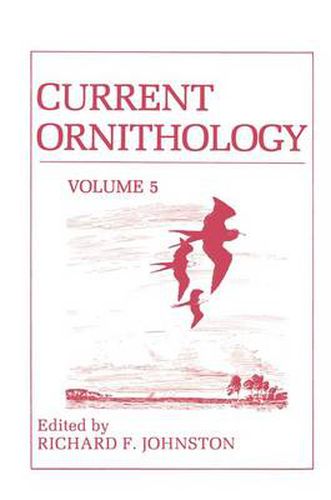Readings Newsletter
Become a Readings Member to make your shopping experience even easier.
Sign in or sign up for free!
You’re not far away from qualifying for FREE standard shipping within Australia
You’ve qualified for FREE standard shipping within Australia
The cart is loading…






This title is printed to order. This book may have been self-published. If so, we cannot guarantee the quality of the content. In the main most books will have gone through the editing process however some may not. We therefore suggest that you be aware of this before ordering this book. If in doubt check either the author or publisher’s details as we are unable to accept any returns unless they are faulty. Please contact us if you have any questions.
Volume 5 of this series continues its coverage of currently active re search fields in ornithology. Because an editor can never be a disin terested observer of his or her own editorial efforts, any claim for su periority of this volume is not without conflict of interest. Even so, Volume 5 has certain merits that even a parent should acknowledge, and I find the current chapters not merely timely and authoritative but compelling in their demand for a reader’s attention. Wolfgang and Roswitha Wiltschko provide a perceptive review of magnetic orientation in birds, a piece dedicated to Fritz Merkel, the pioneer in studies of magnetic orientation. Sergei Kharitonov and Doug las Siegel-Causey are concerned with the behavioral ecology of seabird coloniality, emphasizing their field experiences in the USSR and the United States. Ted Miller examines the application of studies of bird behavior to comparative biology, pursuing the interface of behavior and evolutionary biology adumbrated by Konrad Lorenz in the 1930s. Jeremy Raynor gives us a summary of the work over the past decade on bird flight, which is not, by turns, as complex or as simple as we had formerly believed. Carrol Henderson describes recent develop ments in nongame bird conservation, based on his pioneering work in the State of Minnesota. Alan Kamil discusses optimal experimental design for research in ornithology, a field in which experimental work is frequently difficult to pursue.
$9.00 standard shipping within Australia
FREE standard shipping within Australia for orders over $100.00
Express & International shipping calculated at checkout
This title is printed to order. This book may have been self-published. If so, we cannot guarantee the quality of the content. In the main most books will have gone through the editing process however some may not. We therefore suggest that you be aware of this before ordering this book. If in doubt check either the author or publisher’s details as we are unable to accept any returns unless they are faulty. Please contact us if you have any questions.
Volume 5 of this series continues its coverage of currently active re search fields in ornithology. Because an editor can never be a disin terested observer of his or her own editorial efforts, any claim for su periority of this volume is not without conflict of interest. Even so, Volume 5 has certain merits that even a parent should acknowledge, and I find the current chapters not merely timely and authoritative but compelling in their demand for a reader’s attention. Wolfgang and Roswitha Wiltschko provide a perceptive review of magnetic orientation in birds, a piece dedicated to Fritz Merkel, the pioneer in studies of magnetic orientation. Sergei Kharitonov and Doug las Siegel-Causey are concerned with the behavioral ecology of seabird coloniality, emphasizing their field experiences in the USSR and the United States. Ted Miller examines the application of studies of bird behavior to comparative biology, pursuing the interface of behavior and evolutionary biology adumbrated by Konrad Lorenz in the 1930s. Jeremy Raynor gives us a summary of the work over the past decade on bird flight, which is not, by turns, as complex or as simple as we had formerly believed. Carrol Henderson describes recent develop ments in nongame bird conservation, based on his pioneering work in the State of Minnesota. Alan Kamil discusses optimal experimental design for research in ornithology, a field in which experimental work is frequently difficult to pursue.